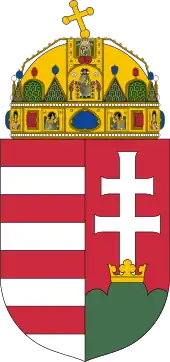Anti-Hungarian sentiment
Anti-Hungarian sentiment (also known as Hungarophobia,[1][2] Anti-Hungarianism, Magyarophobia[3] or Antimagyarism[4]) is dislike, distrust, racism, or xenophobia directed against the Hungarians. It can involve hatred, grievance, distrust, intimidation, fear, and hostility towards the Hungarian people, language and culture.
| Part of a series on |
| Discrimination |
|---|
 |
History
During the existence of the Kingdom of Hungary and Croatia, the Banate of Bosnia was accused of holding the alleged Cathar anti-pope Nicetas. Given that the Kingdom of Hungary and Croatia was under heavy Catholic influence, and Bosnia having a decentralized religious practice, Pope Honorius III would preach about invading Bosnia to pacify Nicetas, whilst Hungary would be able to incorporate Bosnia into its control.[5] Later, in 1235, Hungary, with the justification of Pope Gregory IX would launch the Bosnian Crusade in order to subdue the Banate under its control.[5] However, in 1241, the Mongols invaded Hungary, thus completely abandoning the crusade and returning to Hungary to bolster their armies against the Mongols.[6] Bosnia would then regaining its previously conquered territory.[7] This conflict would fuel anti-Hungarian sentiment within the state, which even lasted beyond towards the Ottoman conquest of Bosnia.[8]
During the era of the Austro-Hungarian monarchs, the court in Vienna was influenced by Hungarophobia, but the Hungarian landowner nobles also showed signs of Germanophobia.[9] In the 18th century, after the end of Rákóczi's War of Independence, many immigrants came to the underpopulated southern parts of the Kingdom of Hungary: for instance, 800 new German villages were established.[10] The authorities preferred non-Hungarian settlers. The Habsburgs regarded the Hungarians as "politically unreliable", and consequently they were not allowed to settle in the southern territories until the 1740s.[11] The organized resettlement was planned by the Habsburgs. The resettlement policy was characterized as anti-Hungarian,[12][13] as the Habsburgs feared an uprising of Protestant Hungarians.[14]
Thousands of Hungarians were murdered in Transylvania (now part of Romania) in nine separate incidents during the 1848–1849 massacres in Transylvania, in which Romanians were also massacred in four separate occasions.
Modern
Czechoslovakia
Minorities in Czechoslovakia in 1918 to 1939 enjoyed personal freedoms and were properly recognized by the state. There were three Hungarian and/or Hungarian-centric political parties:
- Hungarian-German Social Democratic Party
- Hungarian National Party
- Provincial Christian-Socialist Party
After World War II, Czechoslovakia became a communist state; during the transition to a communist one-party state, decrees permitting the forced[15] expulsion of German and Hungarian minorities from ethnic enclaves in Czechoslovakia came into effect, and Hungarians were forcibly relocated to Sudetenland, on the borders of Czechoslovakia. The Czechoslovak government deported more than 44,129 Hungarians from Slovakia to the Sudetenland for forced labor[16][17] between 1945 and 1948,[17] and the Beneš decrees remain legally in effect in the Czech Republic.[18]
Slovakia
In Slovakia, Hungarian and pro-Hungarian political parties are a stable part of the political system. Anti-Hungarian sentiment had been criticized particularly during the third government of Vladimír Mečiar. In the past, so-called "Hungarian card" had been used mainly by the Slovak National Party (SNS)[22] against the granting of a special status to the Hungarian minority; it argued for the complete assimilation of the Hungarian minority into Slovak society. It considers that Hungarians in Slovakia are actually overprivileged.[22][23] After personnel changes in the presidium, SNS abandoned similar rhetoric and formed a common government with pro-Hungarian Most-Híd in 2016.
Anti-Hungarian rhetoric of some far-right organizations in Slovakia is based on historical stereotypes and conflicts in the common history as interpreted from nationalistic positions and recent events. In such interpretations, the arrival of old Hungarian tribes is described as the occupation by barbarian tribes and contributed to the destruction of Great Moravia. Other negative sentiments are related to the period of Magyarization, the policy of interwar Hungary, the collaboration of Hungarian-minority parties with the Hungarian government against Czechoslovakia, the First Vienna Award and the Slovak–Hungarian War.[24] Hungary is accused of still trying to undermine the territorial integrity of Slovakia, and local minority politicians are accused of irredentism.[24] However, anti-Hungarian sentiment is not typical even for all far-right organisations, and the leader of the Slovak Brotherhood emphasized the need for collaboration with Hungarian far-right organisations against materialism and multiculturalism.[24]
Women, Slovak or not, used to be required to affix the Slovak feminine marker -ová (used for declension of feminine names) at the end of their surname.[25]
One incident of ethnically-motivated violence against Hungarians in Slovakia was at a football match in Dunajská Streda when Hungarian fans were badly beaten by the Slovak police.[26]
The majority and the Hungarian minority describe their coexistence mostly as good. For example, in a public survey in 2015, 85.2% of respondents characterized their coexistence as good (63.6% rather good, 21.6% very good) and only 7.6% as bad (6.3% rather bad, 1.3% very bad).[27]
Romania
In Romania, the Ceaușescu regime gave great focus to the ancient history of Transylvania.[28] National communism in Romania made historical personalities of Hungary (such as John Hunyadi or György Dózsa)[29][30] go through Romanianization and become more central figures in Romanian history.[28]
The Civic Forum of the Romanians of Covasna, Harghita and Mureș, founded in 2005 with the aim of coordinating the ethnic Romanians at Covasna, Harghita and Mureș counties,[31] has been accused of being anti-Hungarian.[32][33][34]
Ukraine
Derogatory terms
In English
In Romanian
The slurs Bozgor, Bozgoroaică and Bozgori are pseudo-Magyar terms of possible Romanian or Slavic origin describing Hungarians. A view is that it means "homeless" or "stateless".[37] N. Sándor Szilágyi speculated that the word is a combination of the Hungarian slur ba(s)zd meg ("fuck you") and the Romanian word for Hungarian, namely ungur.[38]
See also
References
- Viktor Karády, The Jews of Europe in the Modern Era: A Socio-Historical Outline, Central European University Press, 2004, p. 223
- András Bán, Hungarian-British Diplomacy, 1938–1941: The Attempt to Maintain Relations, Routledge, 2004, p. 128
- Boyer, John W. (2009). Culture and Political Crisis in Vienna: Christian Socialism in Power, 1897–1918. University of Chicago Press, 1995. p. 116. ISBN 9780226069609.
- Verdery, Katherine (1989). National Ideology Under Socialism: Identity and Cultural Politics in Ceauşescu's Romania. University of California Press, 1995. p. 317. ISBN 9780932088352.
- Lock, Peter (2006). The Routledge companion to the crusades. London: Routledge. ISBN 978-1-135-13137-1. OCLC 842263762.
- Fine, John V. A. (1994). The late medieval Balkans: a critical survey from the late twelfth century to the Ottoman Conquest. Ann Arbor. ISBN 978-0-472-10079-8. OCLC 749133662.
{{cite book}}: CS1 maint: location missing publisher (link) - Janet Hamilton; Bernard Hamilton; Yuri Stoyanov, eds. (1998). Christian dualist heresies in the Byzantine world, c. 650-c. 1450: selected sources. Manchester, UK: Manchester University Press. ISBN 0-7190-4764-1. OCLC 37373494.
- Fine, John V. A. (2007). The Bosnian Church: its place in state and society from the thirteenth to the fifteenth centuries: a new interpretation. London: Saqi / The Bosnian Institute. ISBN 978-0-86356-503-8. OCLC 74526539.
- Michael Hochedlinger, Austria's Wars of Emergence: War, State and Society in the Habsburg Monarchy, 1683–1797, Pearson Education, 2003, p. 25
- Thomas Spira, German-Hungarian relations and the Swabian problem: from Károlyi to Gömbös, 1919–1936, East European quarterly, 1977, p. 2
- Kocsis, Károly; Kocsis-Hodosi, Eszter (1998). Ethnic Geography of the Hungarian Minorities in the Carpathian Basin (PDF). Translated by Bassa, László; Merrick, Marion (Translated from the Hungarian ed.). Geographical Research Institute, Research Centre and Earth Sciences. p. 140. ISBN 978-963-7395-84-0.
- Hídfő könyvtár, Volume 8, Issue 1, p. 48
- Istvàn Sisa, Magyarságtükör: nemzet határok nélkül, Püski, 2001, p. 99 Cited: "Magyarellenes betelepítési politika. A felszabadulást követően a Habsburgok olyan betelepítési politikát alkalmaztak, mely még tovább gyengítette a magyarok helyzetét." Translation: "(Section name) Anti-Hungarian resettlement policy. After the liberation, the policy employed by the Habsburgs weakened the situation of Hungarians more."
- Tibor Iván Berend, Éva Ring, Helyünk Európában: nézetek és koncepciók a 20. századi Magyarországon, Volume 1, Magvető, 1986, p. 144 Cited: "A Habsburg-család azonban a kálvinista magyarok lázadásától való félelmében az évszázados török háborúk által elpusztított területen magyarellenes telepítési politikát kezdeményezett" Translation: "The Habsburg family initiated an anti-Hungarian resettlement policy in the destroyed territories (caused by hundreds of years of Turkish wars) because of their fear of an uprising of Calvinist Hungarians"
- Thum, Gregor (2006–2007). "Ethnic Cleansing in Eastern Europe after 1945". Contemporary European History. 19 (1): 75–81. doi:10.1017/S0960777309990257. S2CID 145605508.
- Eleonore C. M. Breuning, Dr. Jill Lewis, Gareth Pritchard, Power and the people: a social history of Central European politics, 1945–56, Manchester University Press, 2005, p. 140
- Anna Fenyvesi, Hungarian language contact outside Hungary: studies on Hungarian as a minority language, John Benjamins Publishing Company, 2005, p. 50
- "Radio Prague – The "Benes decrees" – a historian's point of view". 18 August 2003. Retrieved 25 September 2015.
- "Separatist Movements Seek Inspiration in Kosovo". Der Spiegel. 22 February 2008. Retrieved 6 August 2008.
- Jan Cienski. "Slovakia and Hungary just won't get along". GlobalPost. Retrieved 25 September 2015.
- "The World from Berlin: Slovakia and Hungary 'Dangerously Close to Playing with Fire'". Spiegel. 25 August 2009. Retrieved 25 September 2015.
- Cohen, Shari J. (2009). Politics Without a Past: The Absence of History in Postcommunist Nationalism. Duke University Press, 22 Nov 1999. p. 140. ISBN 978-0822323990.
- Hungarian Human Rights Foundation Archived 5 January 2011 at the Wayback Machine New Slovak Government Embraces Ultra-Nationalists, Excludes Hungarian Coalition Party
- Danilov, Sergej; Nociar, Tomáš, eds. (2012). Milovaní a nenávidení: Podobnosti a rozdiely medzi slovenskou a maďarskou krajnou pravicou [Loved and hated: Similarities and differences between Slovak and Hungarian far-right]. Bratislava: Inštitút pre medzikultúrny dialóg. pp. 12–13. ISBN 978-80-970915-0-7.
- Bernd, Rechel (2009). Minority rights in Central and Eastern Europe. Taylor & Francis. ISBN 978-0415590310.
- "Football riot stokes tension". spectator.sme.sk. 10 November 2008. Retrieved 4 April 2014.
- "Prieskum: Vzťahy Slovenska a Maďarska sa za posledných 10 rokov zlepšili" [Survey: Relationships between Slovakia and Hungary has improved over the last 10 years] (in Slovak). Pravda.sk. 20 September 2015. Retrieved 23 August 2016.
- Lucian Boia, History and Myth in Romanian Consciousness, Central European University Press, 2001, p. 222 Citation:"....Thanks to the trios of Gelu, Glad and Menumorut, and Horea, Cloșca and Crișan, the Transylvanian heroes are actually more numerous than those of Wallachia or Moldavia, illustrating the obsession with Transylvania and the Hungarophobia that became accentuated towards the end of the Ceaușescu era."
- "Rethinking National Identity after National-Communism? The case of Romania (by Cristina Petrescu, University of Bucharest)". www.eurhistxx.de. Archived from the original on 5 March 2014. Retrieved 3 April 2014.
- The Hungarian national component of the movement led by Dózsa was de-emphasized, while its strong antifeudal character was highlighted: (in Romanian) Emanuel Copilaş, "Confiscarea lui Dumnezeu şi mecanismul inevitabilităţii istorice" Archived 21 July 2011 at the Wayback Machine, Sfera Politicii 139, September 2009
- "A fost înființat Forumul Civic al Românilor din Harghita și Covasna". Basilica News Agency (in Romanian). 4 June 2005.
- "Román nacionalista szervezetek Sepsiszentgyörgyön állítanának szobrot Mihai Eminescunak". Vasárnap.hu (in Hungarian). 17 November 2022.
- "Sepsiszentgyörgy és Kovászna megye zászlói miatt pereli a kormányt a románok fóruma". Ehír (in Hungarian). 27 December 2021.
- "Betiltottak egy magyarellenes tüntetést Romániában". Alfahír (in Hungarian). 21 February 2020.
- "Bohunk – Definition of bohunk by Merriam-Webster". Retrieved 25 September 2015.
- "bohunk" in the Canadian Oxford Dictionary, Second Edition, Oxford University Press, 2004.
- Vilmos Tánczos, Language Use, Attitudes, Strategies. Linguistic Identity and Ethnicity in the Moldavian Csángó Villages, Editura ISPMN, 2012, p. 130
- "Bozgor" (PDF). transindex.ro (in Romanian). 1988. Retrieved 23 April 2023.
Bibliography
- Gerő, András; Patterson, James (1995). Modern Hungarian society in the making: the unfinished experience. Central European University Press.

